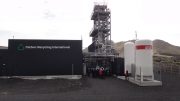
You just can’t drink enough soda to create a market for bottling and storing all the excess carbon dioxide in the atmosphere.
But as researchers look for ways to stave off global warming by reducing atmospheric CO2, many have turned to a related idea. Carbon capture, utilization and storage (CCUS) is one strategy–along with others such as solar energy, biofuels and energy efficiency–that can work together to rein in runaway greenhouse gases.
If CCUS were applied broadly across the U.S. manufacturing sector, it could save hundreds millions of tons of industrial greenhouse gas emissions from entering the atmosphere every year. The trick is demonstrating that it makes economic sense.
A team led by Los Alamos National Laboratory worked out a CCUS model that just might deliver the financial return investors need. It relies on a surprising source: the ethylene manufacturing plants that make plastic bags and packaging from natural gas.
The Los Alamos–led research team explored capturing CO2 from ethylene manufacturing plants. The ethylene plants, clustered in the U.S. Gulf Coast, can recover their carbon capture costs by selling the CO2 to nearby depleted oil fields and using the gas to extract up to 15 percent more oil.
Capturing CO2 emitted from ethylene manufacture and using that CO2 for enhanced oil recovery lowers the carbon footprint of gasoline use by approximately one third.
The team’s study found that large, clustered sources of ethylene coupled with the high demand for CO2 in enhanced oil recovery could support an integrated pipeline network from New Mexico across the Gulf region to Mississippi. This kind of a large, commercially viable and fully integrated CO2 capture network could stimulate wide-ranging industry “buy-in.”
The implications are global. Even as nations increase their share of renewable energy, fossil fuels will remain an economic driver for decades. For instance, China and India are committed to coal-fired electric plants for decades and CCUS is the only technology capable of reducing those CO2 emissions. A large-scale carbon-capture network can go a long way to reducing the environmental impact of fossil fuel use.
Most researchers recognize that turning around climate change involves deploying multiple strategies, and CCUS has the advantage of reducing carbon emissions during a transition from fossil fuels to other energy sources. As such, it is poised to help transition the global energy economy to a cleaner, more diversified energy future.
6 May, 2016
Richard S. Middleton
Los Alamos National Laboratory
Editor’s Note: This post was written by a scientist at Los Alamos National Laboratory, one of the Department of Energy’s 17 National Labs.






Be the first to comment on "Plastic Bags Might Kickstart the Carbon Capture Industry"